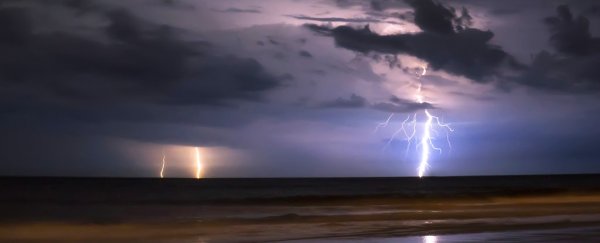There's an increase in lightning storms at sea, and the culprit is the exhaust produced by diesel-powered cargo ships, a new study has found.
Our oceans are criss-crossed with invisible lanes taken by cargo ships, and now it turns out those heavily trafficked areas have surprisingly different weather.
Diesel fumes are some of the worst pollutants. We know that they're significantly worse for human health than petrol fumes, and a new study has just found that they're responsible for 5,000 premature deaths annually in Europe.
And it turns out particles in that exhaust are also responsible for an increase in lightning, according to a team of researchers from the University of Washington.
Using 12 years of lightning strike data from the World Wide Lightning Location Network, the team found that lightning strikes were occurring nearly twice as often directly above two heavily trafficked shipping lanes, compared to adjacent areas of the ocean with similar climates.
This difference over the shipping channels over the Indian Ocean and the South China Sea cannot solely be attributed to changes in weather, the researchers said.
"[We made] a map of where the lightning was enhanced and a map of where the ships are traveling and it was pretty obvious just from the co-location … that the ships were somehow involved in enhancing lightning," says lead researcher Joel Thornton.
Clouds form when water vapour in the atmosphere clings to particles in the air. We know this can be induced, because scientists have been experimenting with a practice called "cloud seeding" for decades.
This involves pumping particles into the air for the vapour to cling to, such as dry ice particles.
This is what could be happening with the diesel exhaust. But the particles therein are more numerous than would be normally in the atmosphere, meaning the water vapour has more particles to collect around.
This results in smaller and lighter cloud particles, which are lifted higher into the atmosphere, past the freezing line, where they form soft hail and ice crystals.
These then collide with each other, creating the electrical charge that results in lightning.
The team studied 1.5 billion lightning strikes produced between 2005 and 2016, and believe their findings represent the first evidence that humans are influencing cloud formation on a continual basis, rather than periodically, such as after a wildfire.
Cloud formation can also affect climate by changing how much sunlight is reflected back into space.
"It is the first time we have, literally, a smoking gun, showing over pristine ocean areas that the lightning amount is more than doubling," says atmospheric scientist Daniel Rosenfeld of Hebrew University of Jerusalem who didn't participate in the study.
"The study shows, highly unambiguously, the relationship between anthropogenic emissions - in this case, from diesel engines - on deep convective clouds."
The research has been published in the journal Geophysical Research Letters.
